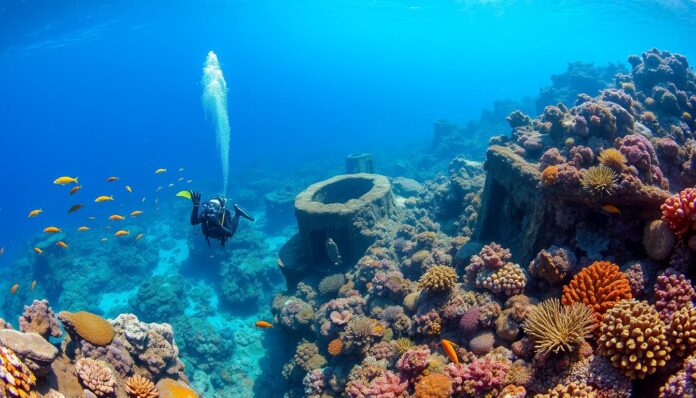| Best Time to Travel | May to October (summer) |
| What to Expect | Visibility of up to 100 feet, warm water (68-82°F), diverse marine life |
| Diving Conditions | Year-round diving, but best during the summer (calmer seas, warmer water) |
| Marine Life | Groupers, moray eels, octopuses, turtles, dolphins, shipwrecks |
Are you ready to discover the hidden treasures of Scuba Diving in Italy? Italy’s 7,000 km coastline invites divers from everywhere to dive into its stunning Mediterranean waters.
Exploring Italy’s underwater world is an amazing adventure. From Liguria’s rocky shores to Sicily’s tropical seas, each place offers a special dive experience. It’s perfect for both new and seasoned divers.
The Mediterranean around Italy is home to incredible marine life. You can dive at sites like ancient underwater mills in Abruzzo or the clear waters of Lampione. These dives mix natural beauty with history, making every dive unique.
Key Takeaways – Scuba Diving in Italy
- Italy offers over 7,000 km of diverse coastline for diving
- Underwater sites include historical and natural marine environments
- Diving depths vary from 18 to 40 meters across different regions
- Marine life includes endemic species and tropical fish
- Each region offers unique underwater exploration opportunities
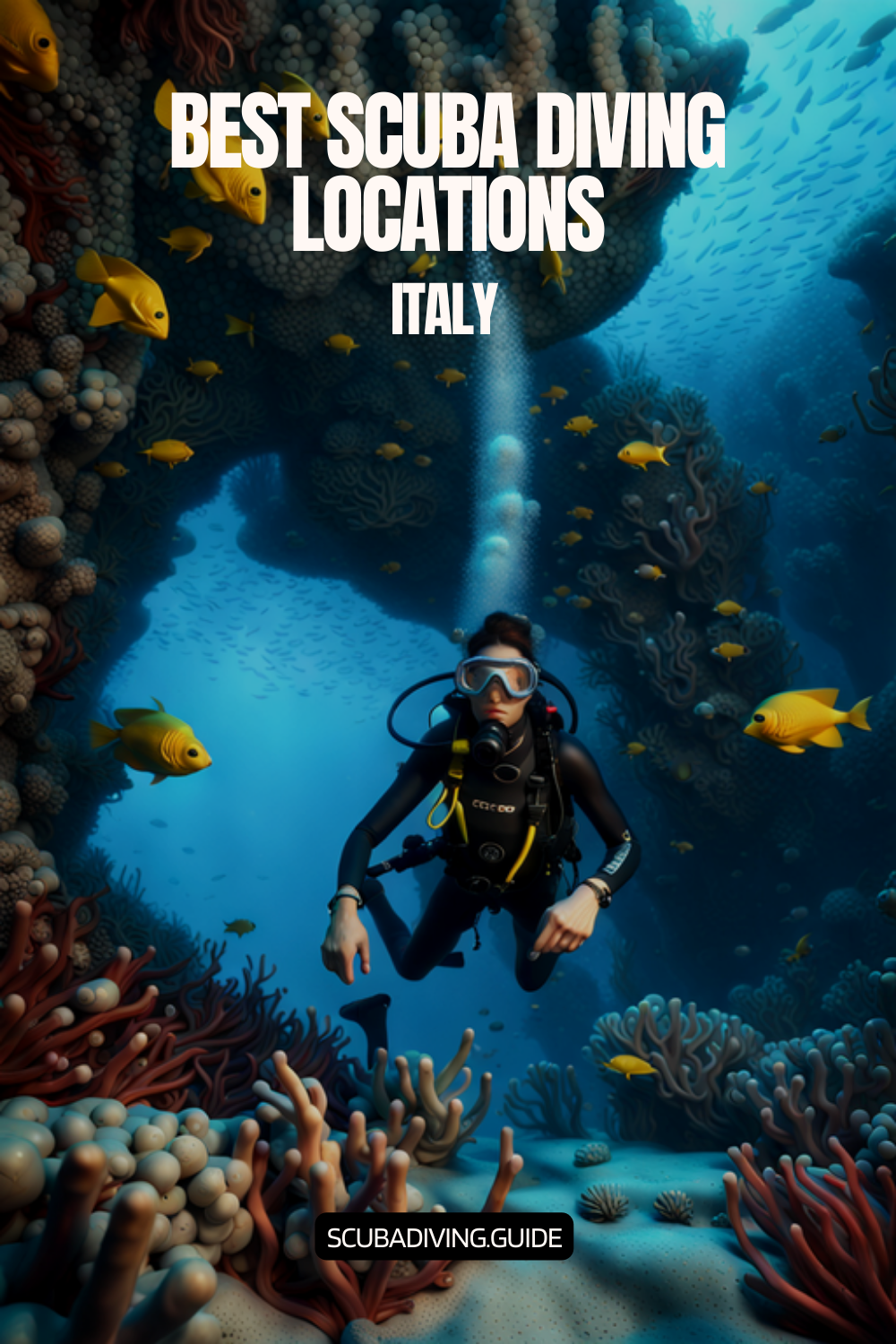
Introduction to Scuba Diving in Italy
Italy’s underwater world is a treasure for scuba diving fans worldwide. The Marine Life Mediterranean is full of diverse marine life and beautiful landscapes. Dive Sites Italy offer unique experiences that mix nature and history.
Diving in Italy is more than a sport; it’s a journey into a fascinating marine world. The Mediterranean Sea is home to many marine ecosystems. These challenge and amaze divers of all levels.
Overview of the Mediterranean’s Rich Biodiversity
The Mediterranean Sea is known for its incredible marine life. Divers will see a vibrant underwater world with:
- Colorful groupers hiding among rocky formations
- Sleek barracudas patrolling crystal-clear waters
- Diverse fish species in stunning color variations
- Rare marine plants and detailed coral formations
“Every dive in the Mediterranean is a chance to explore a living, breathing underwater museum.” – Professional Marine Biologist
The Scuba Diving Experience in Italy
Italian dive experiences combine natural beauty with history. Divers can see underwater archaeological sites, marine protected areas, and unique geological formations. These environments cater to all, from beginners to seasoned explorers.
| Dive Site Characteristic | Details |
|---|---|
| Average Dive Depth | 21 meters (70 feet) |
| Marine Species Encounters | Over 100 barracuda per dive |
| Introductory Dive Price | €95.00 per person |
| Dive Duration | 3 hours |
Get ready for an unforgettable underwater adventure. It combines natural beauty, marine life exploration, and historical discovery in the Mediterranean.
Top Scuba Diving Destinations in Italy
Italy’s underwater world is a treasure trove for scuba lovers from everywhere. It has a variety of marine landscapes and historical sites. This makes it perfect for both new and seasoned divers looking for Scuba Certification Italy.
Those looking for Scuba Tours Italy will find amazing places. These spots show off the Mediterranean’s beauty and history.
The Amalfi Coast: A Scenic Underwater Paradise
The Amalfi Coast is a dream for divers. A must-see is the Christ of the Abyss statue, 17 meters down. It’s a bronze figure that draws divers of all levels.
- Statue depth: 17 meters
- Accessible from shore
- Suitable for snorkelers and free divers
Sardinia: Crystal Clear Waters and Vibrant Marine Life
Sardinia is a top spot for diving, with its stunning underwater views. The Grotta del Nereo is home to the world’s biggest mussel, the Pinna Nobilis fan mussel.
| Dive Site | Special Features | Difficulty Level |
|---|---|---|
| St Elmo’s Rock | Dramatic cave systems | Advanced |
| Angelica Wreck | Historical Japanese tanker | Technical |
Sicily: Dive into History Beneath the Waves
Sicily is like an underwater museum. It has many dive sites with walls, shipwrecks, and caves. Lampedusa Island, at Italy’s southern tip, is great for seeing big sea creatures.
“Sicily transforms diving from a sport into an underwater archaeological adventure” – Mediterranean Diving Magazine
Divers here will see the Mediterranean’s amazing marine life. They’ll also explore some of the world’s most beautiful underwater places.
Best Time of Year for Diving in Italy
Italy is a top spot for diving, with a season from May to October. The Mediterranean waters are perfect for diving during these months. It’s great for both wreck diving and cave diving.
The diving in Italy changes a lot throughout the year. Summer is the best time, with warm waters and clear views underwater.
Seasonal Weather Conditions
Divers find the best conditions at certain times:
- May to October: Peak diving season with warmest waters
- June to August: Best time for marine life encounters
- Winter months: Water temperatures drop to 10-13°C
“The Mediterranean reveals its true beauty during the summer months, transforming Italy’s coastline into an underwater paradise.”
Popular Events and Diving Festivals
Italy has many diving events that draw divers from everywhere. The coastline offers many diving spots, like the Tremiti Islands and the Portofino Marine Park.
| Region | Diving Highlights | Best Months |
|---|---|---|
| Sicily | Roman wreck sites, Marine diversity | May-October |
| Sardinia | Marine Protected Areas, Cave diving | June-September |
| Liguria | Up to 30m visibility | July-August |
Whether you dive wrecks or caves, diving in Italy’s peak season is unforgettable. Each area has its own beauty and adventures.
Equipment and Gear for Scuba Diving
Getting ready for an underwater adventure in Italy means you need the right stuff. Whether you’re into Snorkeling Italy or Freediving Italy, having the right gear is key. It makes your dive safe and fun.
Diving in Italy’s clear waters needs special gear for safety and comfort. Both pros and hobbyists know picking top-notch gear is vital. It’s all about the Mediterranean diving conditions.
Essential Gear for New Divers
For beginners, some gear is a must:
- Mask with perfect seal and clear vision
- Fins for efficient underwater movement
- Wetsuit appropriate for water temperature
- Reliable diving regulator
- Buoyancy Compensation Device (BCD)
Recommended Brands and Local Shops
Italy is home to amazing diving gear makers and shops. Cressi, a famous Italian brand, has top-notch gear for all diving needs.
| Brand | Specialty | Recommended For |
|---|---|---|
| Cressi | Complete Diving Equipment | All Skill Levels |
| Mares | Advanced Diving Computers | Technical Divers |
| Suunto | Dive Watches | Professional Divers |
Pro tip: Many local dive shops in Italy offer equipment rental. This makes it easy for travelers to dive without buying all the gear.
“The right equipment transforms a good dive into an extraordinary experience.” – Italian Diving Expert
When planning your dive in Italy, focus on quality, comfort, and safety. Each piece of gear is important for a memorable dive.
Dive Courses and Certifications
Italy is a top spot for Scuba Certification Italy. It offers top-notch training and certification programs. Whether you’re a pro or just starting, there’s a diving course for you.
PADI Certification Pathways
The Professional Association of Diving Instructors (PADI) has great training programs. They help beginners become confident divers. These certifications are recognized worldwide and focus on safety and skill.
- Scuba Diver Course
- Duration: 2 days
- Maximum diving depth: 12 meters
- Minimum age requirement: 10 years
- Open Water Diver Course
- Duration: 3-4 days
- Maximum diving depth: 18 meters
- Includes 4 open water dives
Advanced Diving Specializations
For those with more experience, there are specialized courses. These programs improve your skills and knowledge in marine environments. They cater to different interests.
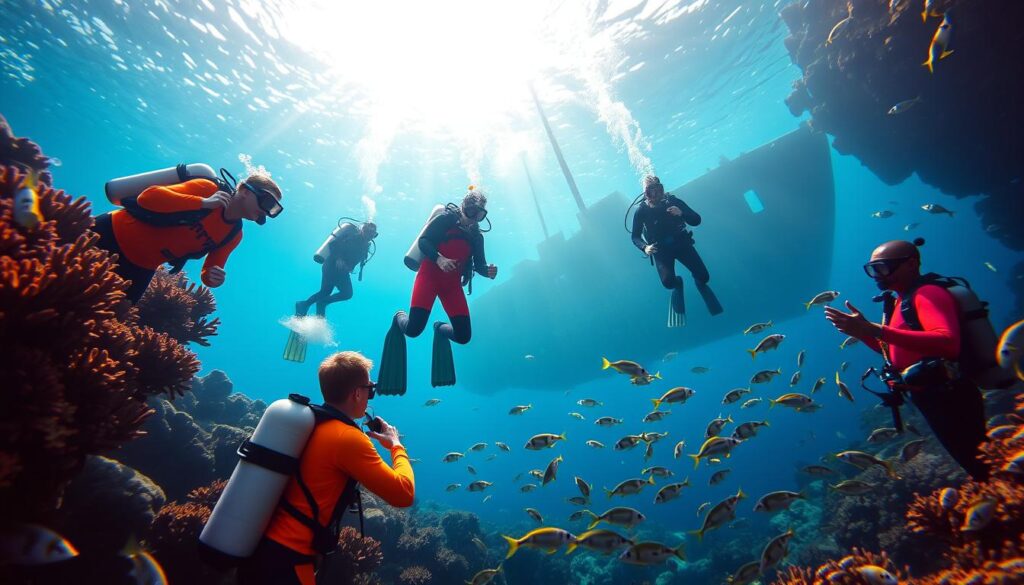
| Course | Duration | Dive Requirements |
|---|---|---|
| Advanced Open Water | 2-3 days | 5 total dives |
| Emergency First Response | 1 day | Safety and rescue techniques |
| Divemaster | 2-3 weeks | Minimum 60 logged dives |
“Every dive is a new adventure, and proper certification ensures you’re prepared to explore the underwater world safely.” – PADI Professional
Italy has over 12,000 diving activities in 25 countries. It’s a great place for divers to grow their skills and explore the underwater world.
Wildlife You Can Expect to See
Exploring Italy’s underwater world is a mesmerizing journey. Divers from all over are drawn to the Marine Life Mediterranean. The Italian coast is home to diverse marine ecosystems, each with its own creatures and landscapes.
Italy’s seas are filled with amazing sea creatures. Every dive is an adventure. You’ll see a wide range of marine life in different areas.
Common Marine Species in Italian Waters
The Mediterranean Sea is full of fascinating marine life. Here are some common creatures you might see:
- Groupers with their large bodies
- Sleek barracudas
- Intelligent octopuses
- Colorful nudibranchs
- Schools of sardines and anchovies
Unique Regional Marine Life
Italy’s different regions offer unique marine wildlife experiences. For example:
- Ligurian Sea: Known for playful dolphin pods
- Amalfi Coast: Home to vibrant nudibranch populations
- Sardinia: Crystal-clear waters hosting diverse fish species
“The Mediterranean is not just a sea, it’s a living museum of marine biodiversity.” – Marine Biologist Research Team
Italy’s underwater world is home to about 289 documented sea fish and invertebrate species. It promises an unforgettable dive for enthusiasts.
Safety Tips for Scuba Diving
Scuba diving in Italy is amazing, but safety is key. Knowing and following important safety steps can make your dive safe and fun.
Experts say 70% of scuba diving accidents are caused by human mistakes. This shows how vital it is to be well-prepared before diving in Italy.
Essential Pre-Dive Safety Checks
Before you dive in Italy, do these important safety steps:
- Check your gear carefully
- Make sure your tank is full
- Practice breathing right
- Check you can talk to your buddy
Critical Safety Guidelines
Being safe is more than just getting ready. Important safety tips include:
- Keep an eye on your air
- Rise slowly to avoid problems
- Stay balanced in the water
- Don’t dive if you’re not feeling well
“Safety in diving is not an option, it’s a necessity.” – Professional Diving Instructor
Local Marine Regulations
Every place in Italy has its own diving rules. Learn the local laws, respect protected areas, and get the right certifications.
With the right preparation and safety steps, your dive in the Mediterranean will be exciting and safe.
Planning Your Dive Trip
Planning Scuba Tours Italy needs careful thought. You must know the different Dive Sites Italy has. Choosing the right place is key to a great dive.
Divers of all levels will find something exciting in Italy’s beautiful coasts. Whether you’re new or experienced, the Mediterranean has amazing marine sights.
Best Regions for Beginner Divers
Some areas are great for beginners:
- Sorrento: Calm waters with gentle currents
- Ischia: Shallow dive sites with excellent visibility
- Elba Island: Protected marine areas ideal for learning
Beginners can expect to pay INR 5,500 to INR 6,700 per dive. These places are affordable for those starting out.
Advanced Dive Sites for Experienced Divers
Experienced divers will find exciting challenges in these spots:
- Ustica Marine Reserve: Deep underwater landscapes
- Sicily’s Aeolian Islands: Complex marine environments
- Portofino: Challenging underwater terrain
“Italy’s underwater world offers something for every diving skill level” – Professional Diving Association
Advanced dive sites cost INR 8,500 to INR 13,500. They offer more complex and challenging dives.
The best time for diving in Italy is from April to November. This period offers the best conditions for diving. Plan your trip based on your skill, budget, and what you want to see underwater.
Local Scuba Diving Schools and Dive Shops
Finding the right scuba diving school in Italy can change your underwater adventure. The Mediterranean has many diving spots. There are many schools that offer Scuba Certification Italy across the country.
Reputable Diving Schools Across Regions
Italy has top-notch dive centers for all levels of divers. From Portofino in the north to Sicily in the south, there are many places to learn. Scuba Tours Italy offer different learning spots.
- Portofino Divers: Started in 2002, with over 20 years of experience
- Ponza Diving Center: Offers courses in recreational and technical diving
- Anemone Diving Center in Syracuse: Has diving spots in Plemmirio Marine Park
- Océano Mare Diving Center: Focuses on organic diving experiences
Pricing and Package Comparison
| Dive Center | Basic Dive Price | Certification Course |
|---|---|---|
| Trapani Argonauta | €37 per one-tank dive | €329 for week package |
| Subaia Campania Divers | €30-€35 per session | Various certification levels |
| Portofino Divers | €40-€50 per dive | Entry-level to advanced courses |
Dive centers are open from April to November. This gives you plenty of time to explore underwater. They offer personal diving experiences with small groups for safety and quality teaching.
“Dive into Italy’s underwater world with confidence and expertise!”
When picking a dive school, look at instructor qualifications, equipment, and course options. Many schools offer training from beginner to professional levels. They also provide PADI certifications and specialty courses.
Underwater Photography Opportunities
Italy is a paradise for underwater photographers. Its diverse coastline offers endless chances to capture the Mediterranean’s beauty. From beginners to pros, Italy’s marine life will inspire and challenge you.
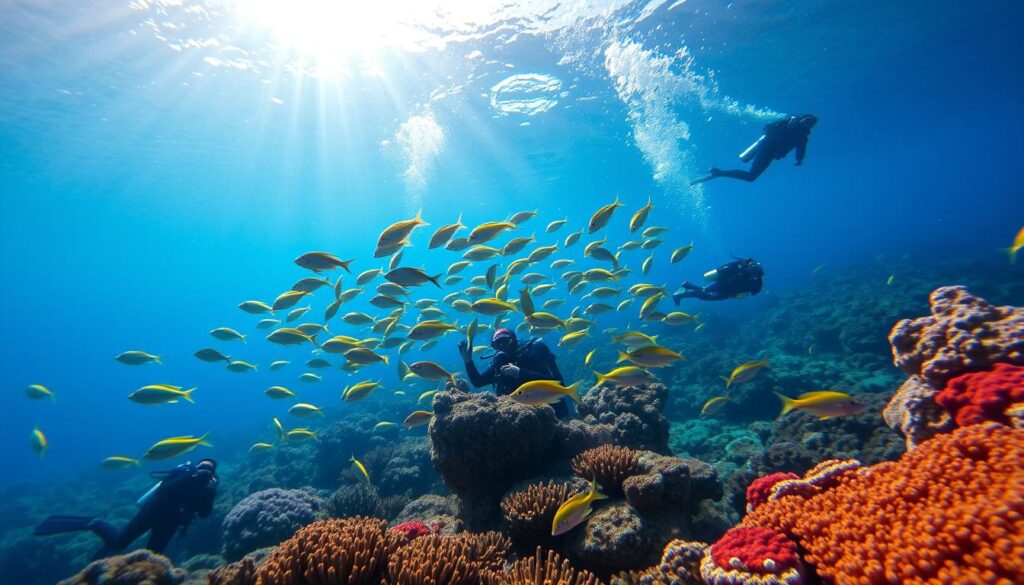
Pietro Formis, a professional photographer, leads workshops in Italy. He focuses on Liguria and Sardinia, where the marine life is incredible. You’ll find everything from tiny nudibranchs to vast underwater caves.
Essential Tips for Capturing Stunning Dive Photos
- Use specialized underwater camera housing
- Master manual white balance settings
- Practice slow, controlled movement
- Select appropriate lens for marine environments
- Understand natural light dynamics underwater
Prime Locations for Underwater Photography
Italy’s coastline is full of amazing spots for underwater photography. The Sorrento Peninsula has over 20 dive sites, with clear water up to 30 meters deep. The Conero Riviera is also a must-see, with its rich marine life.
“Underwater photography in Italy is like painting with light and marine life – each frame tells a unique story of the Mediterranean’s hidden world.”
Expect to see a wide variety of marine life. About 90% of dives feature different species. The best time for photography is from May to September, when the water is calm and clear.
Photography Equipment Recommendations
For underwater photography in Italy, choose top-notch gear. Dive shops offer training and workshops to enhance your skills. This will help you capture the beauty of Italy’s underwater world.
Accommodations Near Dive Sites
Scuba diving in Italy is more than just exploring the sea. The right place to stay can make your trip better. You’ll find many places to stay, each with its own charm and price.
Dive-Friendly Hotels and Hostels
Italy’s coast has special places for scuba lovers. Dive-friendly hotels have cool features for divers:
- Secure gear storage rooms
- Dedicated rinse tanks for equipment
- Dive planning areas
- Proximity to dive centers
Camping for Adventure Seekers
For those who love adventure and saving money, camping is great. It’s a fun way to stay close to the best dive spots in Italy.
| Accommodation Type | Average Price Range | Key Features |
|---|---|---|
| Dive Hotels | €80-€250/night | Professional services, equipment facilities |
| Coastal Hostels | €25-€75/night | Social atmosphere, budget-friendly |
| Camping Sites | €10-€50/night | Direct beach access, natural environment |
“The right accommodation can transform a good diving trip into an unforgettable experience.” – Professional Dive Instructor
Think about where you want to dive, how to store your gear, and if there’s a local dive center nearby. Book early in peak season to get the best spot for your dive adventures.
Sustainable Diving Practices
Exploring the underwater world in Italy means we must protect the sea’s delicate life. Divers are key in keeping these beautiful places safe for all to see. They make sure we can enjoy the marine life in the Mediterranean for years to come.
Diving can harm the ocean. Sadly, plastic waste adds 8 million tons to the sea each year. Also, half of the world’s coral reefs are damaged by us.
Responsible Diving Techniques
- Practice perfect buoyancy control to avoid damaging coral reefs
- Use reef-safe sunscreen to protect marine ecosystems
- Never touch or disturb marine wildlife
- Collect and properly dispose of any underwater trash
Conservation Organizations Supporting Marine Life
| Organization | Focus Area | Impact |
|---|---|---|
| Green Fins | Dive Guide Training | 250+ dive guides trained annually |
| Project AWARE | Marine Conservation | 150+ divers trained in conservation |
| Sottolonda Diving Center | Local Ecosystem Protection | First PADI Eco Center in Italy |
“Every dive is an opportunity to become a steward of the marine environment.”
Diving in Italy needs to be done right. By diving responsibly, we help keep the sea’s life rich and diverse. This way, future explorers can also marvel at the beauty of the Mediterranean.
After Diving Activities
Scuba diving in Italy is more than just exploring the sea. The coastal areas have a lot to offer. They add to your diving trip, making it a full cultural journey.
Exploring Italy’s Coastal Towns
After diving, discover the beauty of coastal towns. Each place has its own culture. It makes your trip unforgettable:
- Stroll through medieval streets in historic villages
- Visit ancient churches and castles
- Explore local museums showing maritime history
- Enjoy traditional craft workshops
Culinary Delights to Savor
Snorkeling in Italy means trying amazing local food. Coastal towns have incredible food experiences. They will make your taste buds happy:
- Seafood Specialties: Fresh seafood cooked in traditional ways
- Regional Wine Tastings: Tastings at vineyards with beautiful views
- Cooking Classes: Learn how to make authentic Italian dishes
“The true essence of Italian coastal life is experienced through its food and culture.” – Local Chef
Italy’s coastal areas offer more than just diving. They give you unforgettable experiences. These experiences go beyond the sea.
Customer Reviews and Experiences
Diving fans have shared amazing stories about their time underwater in Italy. Their words bring to life the incredible marine adventures waiting for travelers at various Dive Sites Italy.
The diving community loves Italian underwater experiences. They give these tours a perfect 5/5 rating. And 100% of participants say their experience was excellent. These tours are a highlight in the Mediterranean diving world.
Diving Testimonials Across Experience Levels
Divers from all levels have praised Italian underwater adventures:
- Beginner divers loved the thorough safety training
- Experienced divers enjoyed the rich marine ecosystems
- Photography fans appreciated the clear underwater views
Top-Rated Dive Tour Experiences
“The attention to detail and customer support during our Scuba Tours Italy experience was extraordinary!” – Professional Diver Magazine
Customers have highlighted several key points:
- Quick and helpful customer service
- Comprehensive dive insurance options
- Flexible booking and rescheduling policies
- Expert instructor support
Customer happiness comes from the tour companies’ dedication to unforgettable underwater experiences in Italy’s stunning dive sites.
Italy Recommended Scuba Diving Itinerary
Planning a scuba diving trip to Italy? Let’s explore a recommended itinerary that allows you to experience the best diving locations the country has to offer.
Day 1: Arrival in Rome
Arrive in Rome, the capital city of Italy, and settle into your accommodation. Take the opportunity to explore the city’s historical landmarks, vibrant culture, and delicious cuisine. Use this day to rest and prepare for your upcoming diving adventures.
Day 2-3: Isola di Ustica
Travel to Isola di Ustica, a marine protected area off the coast of Sicily. Spend two days diving in the pristine waters surrounding the island. Explore vibrant coral reefs, underwater caves, and encounter a variety of marine species, including groupers, barracudas, and dolphins. Enjoy the warm Sicilian hospitality and savor the local cuisine during your stay.
Day 4-5: Sardinia
Fly to Sardinia and make your way to one of the island’s diving hotspots, such as Capo Carbonara or the La Maddalena Archipelago. Spend two days diving in the clear turquoise waters, discovering underwater meadows, rock formations, and an abundance of marine life. Immerse yourself in the beauty of the Mediterranean Sea and soak up the sun on the island’s stunning beaches during your surface intervals.
Day 6-7: Isola del Giglio
Travel to Isola del Giglio, known for its intact shipwrecks and captivating dive sites. Explore the Costa Concordia wreck, a massive underwater attraction that serves as an artificial reef. Dive among the remnants of ancient civilizations and marvel at the marine life that has made these wrecks their home. Take in the island’s natural beauty and enjoy the tranquil atmosphere during your stay.
Day 8-9: Portofino
Make your way to Portofino, a charming coastal village along the Italian Riviera. Dive in the marine reserve of Portofino, known for its colorful sponges, gorgonian forests, and an array of fish species. Experience the unique combination of natural beauty and coastal charm that Portofino offers. Take leisurely walks along the scenic coastline and indulge in the local cuisine and hospitality.
Day 10-11: Amalfi Coast
Travel to the Amalfi Coast, a UNESCO World Heritage Site renowned for its dramatic cliffs, picturesque villages, and azure waters. Dive in the crystal-clear waters along the coastline, exploring underwater caves and admiring the vibrant marine life. Take time to explore the charming towns of Amalfi, Positano, and Ravello, and savor the flavors of the region’s renowned culinary delights.
Day 12: Departure from Naples
Conclude your diving adventure in Italy and depart from Naples. Reflect on the incredible diving experiences, cultural encounters, and memories made during your time exploring Italy’s underwater wonders.
It’s important to note that this itinerary is just a suggestion, and you can customize it based on your preferences, time constraints, and the diving locations you wish to explore. Be sure to check the availability of dive operators, accommodations, and transportation when planning your trip.
Italy offers a plethora of diving opportunities, and this recommended itinerary provides a glimpse into the incredible underwater experiences you can have in this captivating country. Whether you’re a seasoned diver or a beginner, Italy’s diving destinations are sure to leave you with unforgettable memories and a deep appreciation for the beauty of the underwater world.
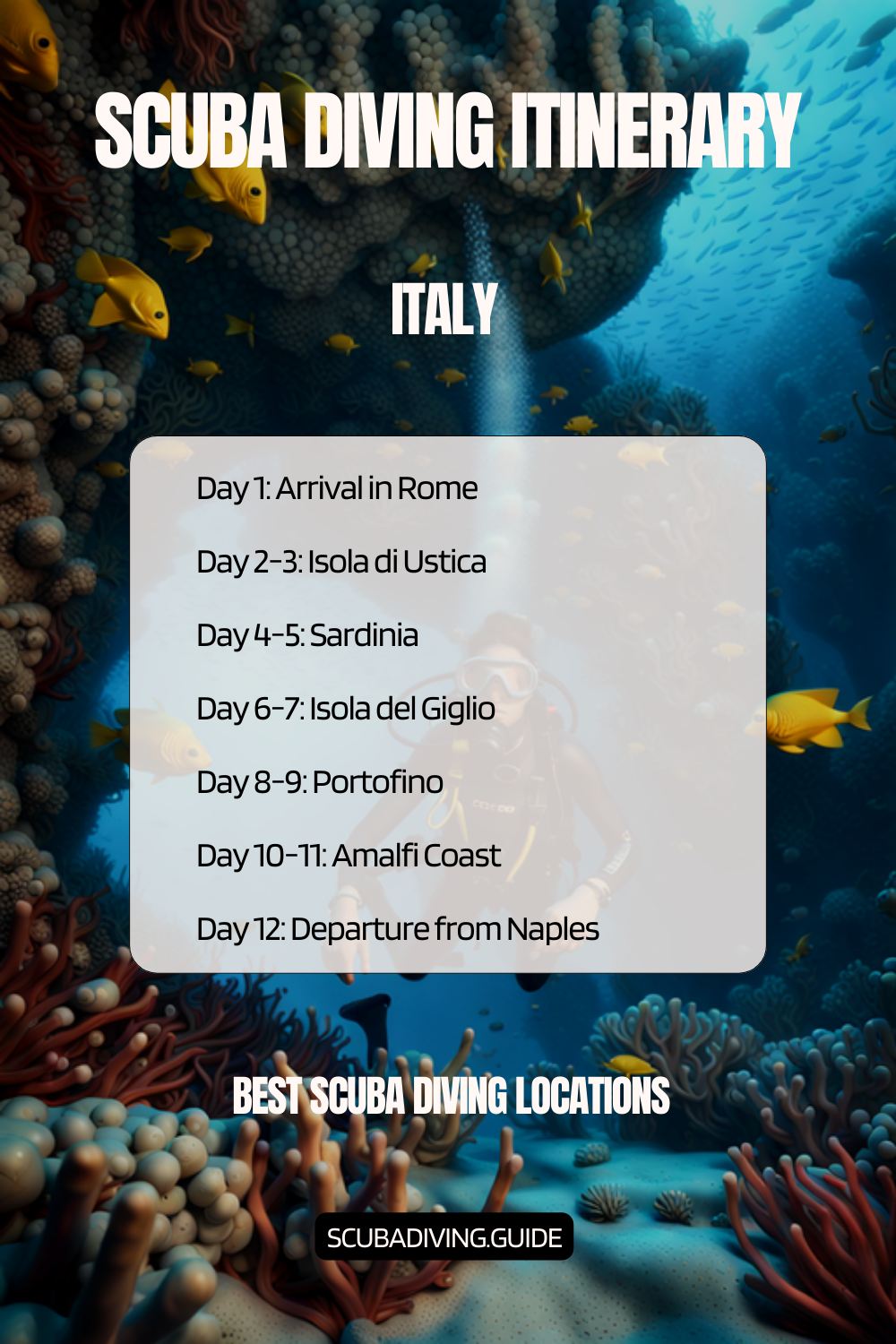
Other Countries to Consider
Conclusion: Dive into Italy’s Underwater Wonders
Scuba diving in Italy is a journey through Europe’s most stunning underwater landscapes. You’ll explore the Underwater Archaeological Park of Baia and vibrant marine ecosystems along the coast. Italy offers a unique blend of natural beauty and cultural heritage.
Why Italy Stands Out for Underwater Adventures
Italy has 10 top scuba diving spots in Sardinia, Sicily, and the Amalfi Coast. You can dive in underwater archaeological parks and colorful coral reefs. The best time to dive is from July to October, with perfect water and clear visibility.
An Invitation to Underwater Discovery
Italy is perfect for those who love marine life like groupers, octopus, and barracudas. It’s also great for exploring underwater historical sites. With dive sites for all levels and a budget-friendly appeal, Italy invites you to explore its underwater wonders.
FAQ – Scuba Diving in Italy
Do I need a special certification to scuba dive in Italy?
You don’t need an Italian-specific certification. But, you’ll need a recognized international one like PADI or SSI. Most dive operators require at least an Open Water certification. Beginners can get certified in Italy before diving in the Mediterranean.
What is the best time of year to go scuba diving in Italy?
The best diving season is from May to October. July and August have the best conditions. The water is warm (23-26°C), and visibility is great.
But, May-June and September-October are also good. They have fewer tourists and great diving conditions.
Are there any dangerous marine creatures I should be aware of in Italian waters?
The Mediterranean is generally safe. But, be careful of scorpionfish, weever fish, and jellyfish. Most marine life is harmless if you keep a distance.
Always listen to local dive instructors about the marine life in your area.
How much does scuba diving cost in Italy?
Prices vary by location and experience. A single boat dive costs €40-€80. Full-day packages are €100-€200.
Certification courses are €350-€500. Sardinia and the Amalfi Coast are pricier. But, some areas are more affordable.
What equipment should I bring for diving in Italy?
Bring your own mask, snorkel, and wetsuit if you can. Dive computers and personal safety equipment are also key. Most dive centers provide tanks and other heavy gear.
Check with your dive operator about what they offer.
Can beginners go scuba diving in Italy?
Yes! Italy is great for beginners. The Amalfi Coast, Sardinia, and Sicily have calm waters and expert instructors. They offer courses and guided dives in safe places.
Are there any conservation efforts I should be aware of while diving?
Italy has many marine protected areas. Divers must follow strict rules. This includes not touching marine life and avoiding coral damage.
Many dive operators are involved in conservation. They can tell you more about diving responsibly.
What marine life can I expect to see while diving in Italy?
The Mediterranean has a rich marine ecosystem. You might see groupers, barracuda, octopuses, and nudibranchs. Dolphins are sometimes spotted too.
Different areas offer unique experiences. Sardinia is known for its vibrant marine life. Sicily has interesting underwater historical sites.
Do I need travel insurance for scuba diving in Italy?
Travel insurance that covers scuba diving is recommended. It should include emergency medical treatment and hyperbaric chamber costs. Many dive operators require proof of insurance.
What language skills do I need for diving in Italy?
Most dive professionals in tourist areas speak English. So, you don’t need to speak Italian. But, learning some basic phrases can be appreciated.
Many dive centers are used to international tourists. They provide instruction in several languages.
